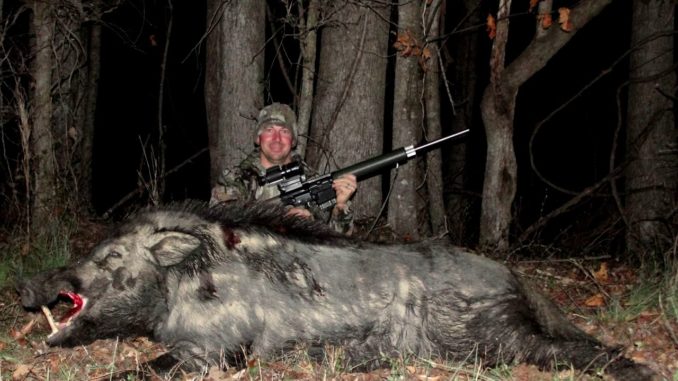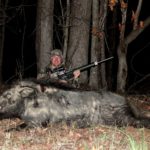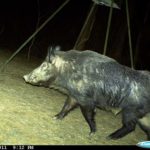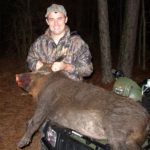
Still-hunt, stands, dogs and traps can help North Carolina hunters put the slam on wild ham.
Even though North Carolina’s deer season ended a month or so ago, big-game hunters looking for a different target can find plenty of action close to home with one of the meanest animals roaming the countryside, the wild hog. And one thing special about them is, hunters can utilize a wide range of creative tactics to bring home the bacon.
Wild hogs, aka feral swine, are becoming abundant across the state. Nearly half of North Carolina’s 100 counties have distinct populations, but hogs have not always been a part of the ecosystem.
Not only was Christopher Columbus responsible for the discovery of America in the 15th century, he and other explorers are credited with introducing the first pigs to North America. Europeans brought supplies, including domestic animals, along to serve as food sources on their worldly travels, but it was April 1912 before the first wild hog stepped onto North Carolina soil. A Graham County game preserve at Hooper’s Bald imported a small group of Eurasian boars for their gated community to serve their wealthy guests’ fancy. It wasn’t long before these animals escaped into the pristine wilderness of the North Carolina mountains, beginning feral swine invasion of the Tarheel State.
Since then, small groups of feral hogs have showed up on properties across the state from domestic populations gone wild. Today, hogs are gaining ground and expanding their territories, right into the hands of anxious sportsman in tree stands or following a pack of hunting dogs. Big-game hunters looking for some action can have plenty of opportunities with one of the meanest, but tastiest, animals around. While wild hog is typically leaner than commercially-grown animals; the taste is very familiar to pork lovers and can be a real bonus for the hunter.
According to Evin Stanford, deer-project biologist for the N. C. Wildlife Resources Commission, there are several core areas with distinct hog populations scattered across the state.
“For decades, the western population in the Pisgah area was classified as wild boar and made up the majority of the state’s population historically,” Stanford said. “Today, some of the bigger populations are in Johnston, Anson, Bladen, Columbus and Brunswick counties.”
Wild hogs are prolific breeders and have been documented to have multiple litters per year. Their reproductive efficiency, lack of natural predators and the ability to adapt to any type of habitat have allowed wild hogs to increase their numbers and take over unoccupied habitats.
Landowners and hunters should have little problem identifying if they have hogs using their properties. They will show themselves shortly after they arrive, leaving swollen mud holes, significant crop and natural vegetation damage and excessive rooting in any type of habitat capable of producing even a marginal food source.
According to Colleen Olfenbuttel, furbearer and bear biologist for the Commission, wild hogs are non-selective grazers and will make a mess doing it.
“They are like a vacuum cleaner. They will eat everything from plant to animal matter without thinking twice about it,” said Olfenbuttel. “They follow their nose and eat all they can until it is gone.”
However, food sources high in fats, carbohydrates, and protein will draw hogs in from a distance and keep them around until they have a reason to leave. Hunters looking to take home a hog for the smoker should hunt around major food sources available during the winter.
“Hogs are somewhat of a nomadic species. They will move until they find a strong food supply, and they will devour the food supply eating themselves out of house and home,” she says. “Hogs will find remnant corn or bait piles placed out for deer.”
The carbohydrate-rich corn is among one of the favorite foods for hogs. Stanford recommends hunters use bait if possible.
“Baiting for hogs can be highly effective,” he said. “Hogs will be the most active near food resources in the early and late periods of the day.”
Hunters can restock corn piles on a routine basis to keep plenty of food around to make the hogs happy and keep them close by. But a word of warning; hogs can be very sensitive to disturbance, and their exaggerated sniffers allow them to smell more than just their midnight snacks.
“Hogs can become weary from unfamiliar smells,” Olfenbuttel said. “They are very aware when pressured.”
Hunters need to pay close attention to scent control during hunts as well as entering and existing the stand sites. Stanford recommends hunters to hunt hogs in a manner similar to deer, with special care to scent control and limited disturbance.
“Don’t disturb them. Stay downwind, rotate stand sites and hunt places where they want to be near food resources,” he said. “They will avoid potential predation and harvesting by people. When pressured heavily, it will drive them nocturnal.”
One bonus: hog hunters don’t have to leave their stands when the sun goes down. In North Carolina, lights can be used to help hunters shoot hogs at night.
Michael Mansell and other members of his White Oak Ranch Hunting Club exclusively utilize lights to kill hogs on their parcels in Edgecombe, Pitt and Bertie counties; the majority of hog movements on their properties were concentrated after dark, in the wee hours of the morning.
“Our trail cameras show that between midnight and 3 o’clock in the morning is the best time to kill hogs on our corn piles,” he said. “We kill over 100 hogs each year, and most are killed at night with the aid of lights” he said. “January through March are the top hog-killing months before the green-up begins, and corn is about all they have to eat on our properties.”
Lights can be either erected above the corn piles, remotes or scope-mounted. Texas’ Elusive Wildlife Technologies (www.elusivewildlife.com) produces a line of illumination devices engineered to provide unthreatening and effective light sources for hunting hogs at night.
While lights can definitely give hunters an advantage, Mansell said hogs can be tough to hunt even at night with lights.
“They appear to be extremely smart, and some will not tolerate any color of light whatsoever.”
As smart as some of these hogs may appear, at some point they will make a fatal mistake on a foggy afternoon before dark or under a moonlit sky at just the right time.
The passage of a new bill by the state legislature last year will likely put more hogs in the crosshairs, day or night. It legalized the use of noise-suppressors, aka silencers, for hunting purposes in North Carolina; that will allow hunters to take multiple hogs in one sitting without causing too much havoc. If used effectively with illumination and optics, hunters could finally get the upper hand on the wild hog epidemic in North Carolina.
From a few isolated introductions to a well-established herd in more than half of North Carolina’s 100 counties, wild hogs are becoming more available to hunters, who should take advantage of liberal regulations to help stem the tide of the habitat destruction that accompanies hogs and load up their freezers and dinner tables with bulk sausage, baby back ribs, bacon and assorted pork chops.







Be the first to comment